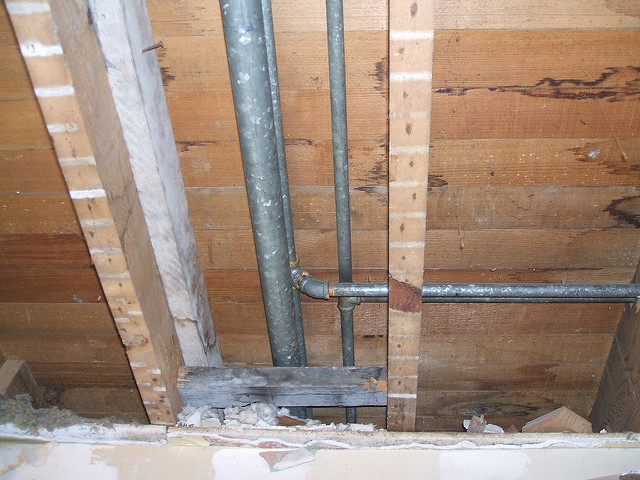In this article in the next paragraph you can find more excellent details in relation to Leaking water lines.

Early detection of leaking water lines can alleviate a potential disaster. Some small water leakages may not be visible.
1. Take A Look At the Water Meter
Checking it is a guaranteed means that helps you find leaks. If it relocates, that indicates a fast-moving leakage. This indicates you may have a slow leakage that might also be underground.
2. Examine Water Usage
Evaluate your water bills as well as track your water consumption. As the one paying it, you need to discover if there are any kind of inconsistencies. If you find sudden changes, in spite of your consumption coinciding, it means that you have leaks in your plumbing system. Bear in mind, your water expense ought to fall under the very same variety each month. A sudden spike in your costs suggests a fast-moving leak.
Meanwhile, a stable rise monthly, even with the exact same habits, reveals you have a slow-moving leakage that's also slowly rising. Call a plumber to completely examine your residential property, especially if you feel a warm area on your floor with piping beneath.
3. Do a Food Coloring Test
When it comes to water intake, 30% comes from bathrooms. If the color in some way infiltrates your bowl throughout that time without flushing, there's a leakage in between the storage tank as well as bowl.
4. Asses Exterior Lines
Don't forget to check your outdoor water lines also. Needs to water leak out of the connection, you have a loose rubber gasket. One little leakage can lose loads of water and increase your water expense.
5. Examine as well as Evaluate the Situation
House owners must make it a routine to check under the sink counters and also even inside closets for any type of bad odor or mold development. These two warnings indicate a leak so punctual interest is called for. Doing routine examinations, even bi-annually, can conserve you from a major issue.
Extra significantly, if you recognize your residence is already old, keep a watchful eye on your heating systems, hoses, pipelines and so on. Check for discolorations as well as deteriorating as the majority of home appliances as well as pipes have a life expectancy. They will also normally wear away as a result of deterioration. Don't wait for it to escalate if you believe dripping water lines in your plumbing system. Call a professional plumber immediately so you do not end up with an awful mess in your house.
Early discovery of leaking water lines can reduce a potential calamity. Some little water leakages might not be noticeable. Examining it is a proven way that helps you discover leaks. One tiny leak can waste tons of water and increase your water costs.
If you presume leaking water lines in your plumbing system, don't wait for it to rise.
How to Know If Your Home Has a Hidden Leak
Water Meter Reveals Inexplicable Water Usage
If you’d like to test whether or not there’s a leak somewhere in your home, you can do this using your water meter. Here is how to conduct the test:
Don’t use any water in your home for at least 30 minutes; this also means not turning on faucets or water-using appliances.
Go outside, and check your water meter for activity.
If your water meter shows that there was activity, even though no one was using any water, this proves that there is a leak in your home.Visible Mold or Mildew Growth
Leaks behind walls create moist, dark environments that allow mold and mildew to grow and thrive. Eventually, you might see mold growth forming on the wall closest to a hidden leak.
If mold is growing in an area that receives a high amount of moisture, such as a bathroom, it may simply be an indication that better ventilation is needed. However, if you see mold growth on a wall or the ceiling in an area where you would not expect, you probably have a hidden leak.
Musty, Mildew Odor
Sometimes you might not be able to see the mold or mildew that is growing as a result of a leak. However, the smell can give the problem away just as easily. If you catch a whiff of something musty, there’s a good chance that old water is collecting somewhere in your home that you can’t see.
Stained/Warped Walls, Ceilings, or Floors
When your home soaks up water, a variety of red flags can become visible, including ceiling stains, bubbling drywall, warped walls, and sagging floors. While these issues can be caused by excess humidity, they can also be signs that a pipe or plumbing connection has started leaking behind your walls.
Inexplicably High Water Bill
After a while, you get a general sense for what your water bill should be. If you own a pool or sprinkler system, your bill will tend to be higher during summer. However, if you receive a water bill that seems especially high, and you can’t figure out what caused it, then you may have a hidden leak somewhere that’s increasing your bill.
https://www.plumbingjoint.com/blog/2019/july/how-to-know-if-your-home-has-a-hidden-leak/

I ran across that write up on Leaking water lines while doing research the web. Do you know anybody else who is sincerely interested in Hacks to detect leaks? Take a moment to promote it. Many thanks for your time. Visit us again soon.